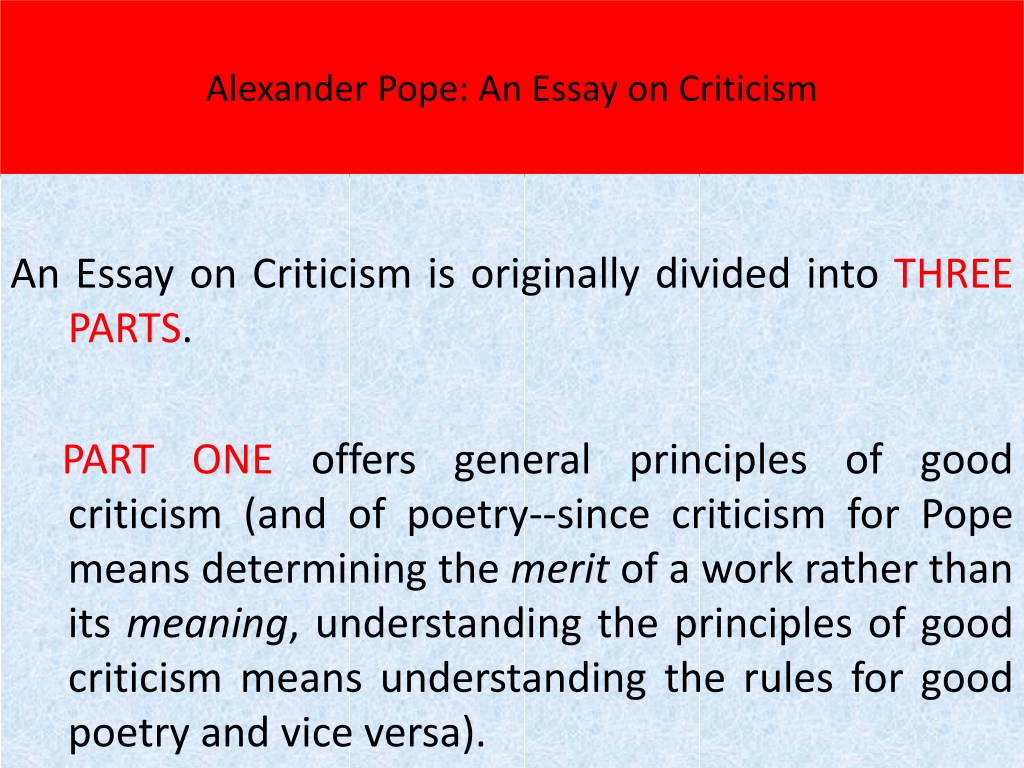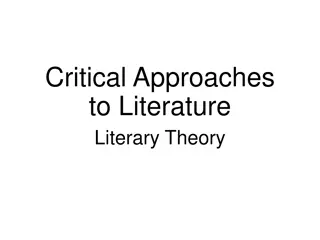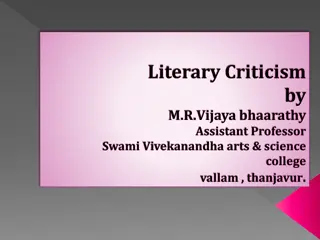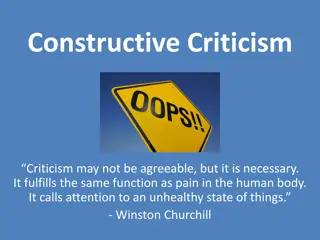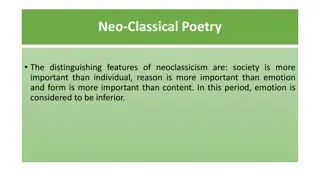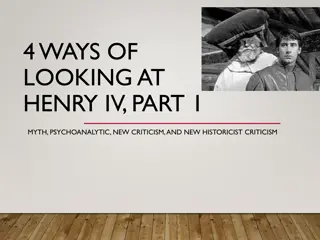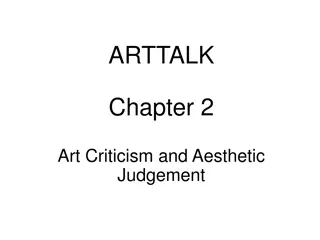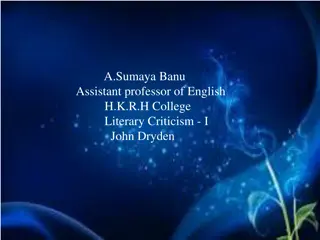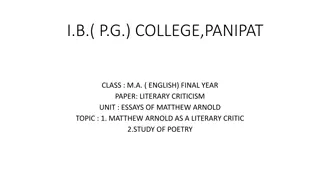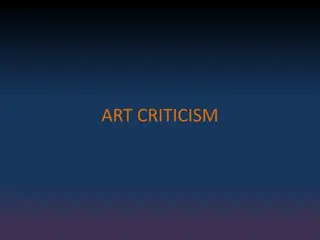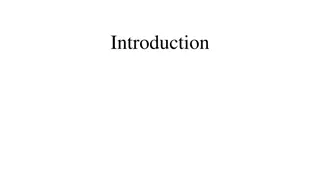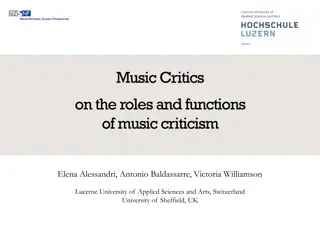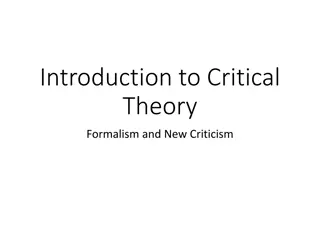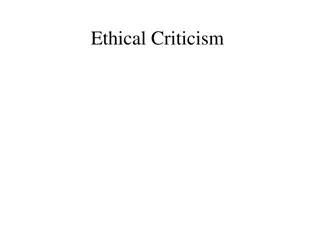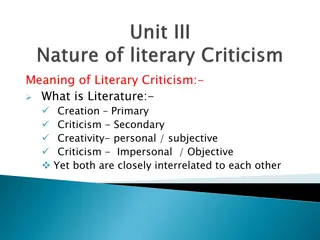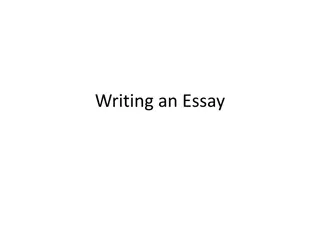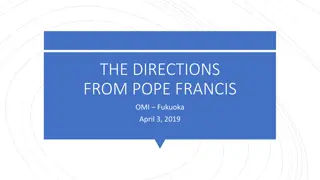Overview of Alexander Pope's "An Essay on Criticism
Alexander Pope's "An Essay on Criticism" is divided into three parts discussing the principles of good criticism, offering solutions to critical problems, and identifying obstacles to good criticism. Part One delves into the challenges critics face due to partial judgments, false learning, and envy. Pope emphasizes the importance of self-awareness and advises following nature and ancient rules while allowing room for creative flexibility. Part Two highlights pride as a major flaw in criticism.
Download Presentation

Please find below an Image/Link to download the presentation.
The content on the website is provided AS IS for your information and personal use only. It may not be sold, licensed, or shared on other websites without obtaining consent from the author. Download presentation by click this link. If you encounter any issues during the download, it is possible that the publisher has removed the file from their server.
E N D
Presentation Transcript
Alexander Pope: An Essay on Criticism An Essay on Criticism is originally divided into THREE PARTS. PART ONE offers general principles of good criticism (and of poetry--since criticism for Pope means determining the merit of a work rather than its meaning, understanding the principles of good criticism means understanding the rules for good poetry and vice versa).
Alexander Pope: An Essay on Criticism Part One He first cites the problem: The problem: "'Tis with our judgments as our watches, none/ Go just alike, yet each believes his own." Judgments are partial, and true taste is as rare as true genius (9-35). Some critics go astray through false learning, others through envy of wit (19-45). Self-awareness is therefore a crucial quality for a critic (46-67): "Be sure yourself and your own reach you know."
Alexander Pope: An Essay on Criticism Part One He then offers solutions for this problem: The first solution: "First follow Nature" (68-87). (Nature here means something like "the universe as God created it" or "that which is permanently true.")
Alexander Pope: An Essay on Criticism Part One The second solution: learn the "rules of old," i.e. the precepts of poetry and criticism set down by the classical Greek and Roman authors or deducible from their literature (88-140). Take care, however, not to follow the rules slavishly, but rather "know well each ancient's proper character," especially Homer.
Alexander Pope: An Essay on Criticism Part One One reason to be flexible in applying the rules: there are "beauties yet no precepts can declare." Great writers can break the rules successfully (141- 180). Modern poets should take care, however, that if they break a rule they should "ne'er transgress its end" (161-169).
Alexander Pope: An Essay on Criticism Part Two PART TWO identifies the main flaws a critic is exposed to, and therefore the greatest obstacles to good criticism. The first and biggest flaw, in criticism as in just about everything else: pride (201-214).
Alexander Pope: An Essay on Criticism Part Two The second flaw is "little learning" (215-232). A little learning makes critics susceptible to pride, by making them think they know more than they do. (Pope is not praising ignorance here; the cure for the pride of little learning is more learning, which teaches the scholar how little he or she knows.)
Alexander Pope: An Essay on Criticism Part Two The third flaw is "a love to parts"--i.e. emphasizing one aspect of a poem at the expense of all others (233-383). A critic SHOULD, instead, "read each work of wit/With the same spirit that its author writ"; "Survey the whole" and "regard the writer's end" (233-252).
Alexander Pope: An Essay on Criticism Part Two The fourth flaw is love of extremes (384-393) The fifth law is liking only "one small sect," e.g. foreign writers, British moderns, as opposed to approving of merit wherever it is found (394-407). author, ancients, or
Alexander Pope: An Essay on Criticism Part Two The sixth flaw is judging authors according to the opinions of others rather than the merit of the work (408-424). E.g.: judging the name rather than the work (412-413). worst case: judging the work on the basis of social rank (414-424). The seventh flaw is prizing novelty above everything else (424-451).
Alexander Pope: An Essay on Criticism Part Two The eighth flaw is valuing only those works which agree with one's own views, or written by friends or members of one's own party, etc. (452-473). Envy plays a big part here, says Pope.
Alexander Pope: An Essay on Criticism Part Three PART THREE celebrates a good critic and concludes with a short history of literary criticism and a catalog of famous critics.
Alexander Pope: An Essay on Criticism Part Three A critic has to be moral. As a judge you do not have to create enemies but friends. (560-565) If you are not sure, do not speak. No one is right all the time and no one is wrong all the time. (566- 569) Back to self knowledge. Pope suggests the importance of self knowledge. (570-571)
Alexander Pope: An Essay on Criticism Part Three Know when to speak even if your analysis is beneficial. It is always best to teach people, who are educated, in a way that doesn t show them they are being educated. Express your thoughts in a nice way. (572-574) If you are going to teach people, criticize them, but you should leave dangerous truth to satire and you should leave flattery to dedication. (592-593)
Alexander Pope: An Essay on Criticism Part Three Too much reading may lead a critic to have a blockhead. If you read too much, you ll start to see similarities everywhere. A good critic should also avoid mentioning his relationship with authors even if it is true. (612-627)
Alexander Pope: An Essay on Criticism Part Three Finally, Pope asks a question about the man who can embody all the qualities of a good critic: But where's the man, who counsel can bestow,/ Still pleas'd to teach, and yet not proud to know? (631- 632). In what follows, Pope does not give a specific answer, instead he mentions classical figures that are used as examples.
THE END SEE NEXT LESSON!
